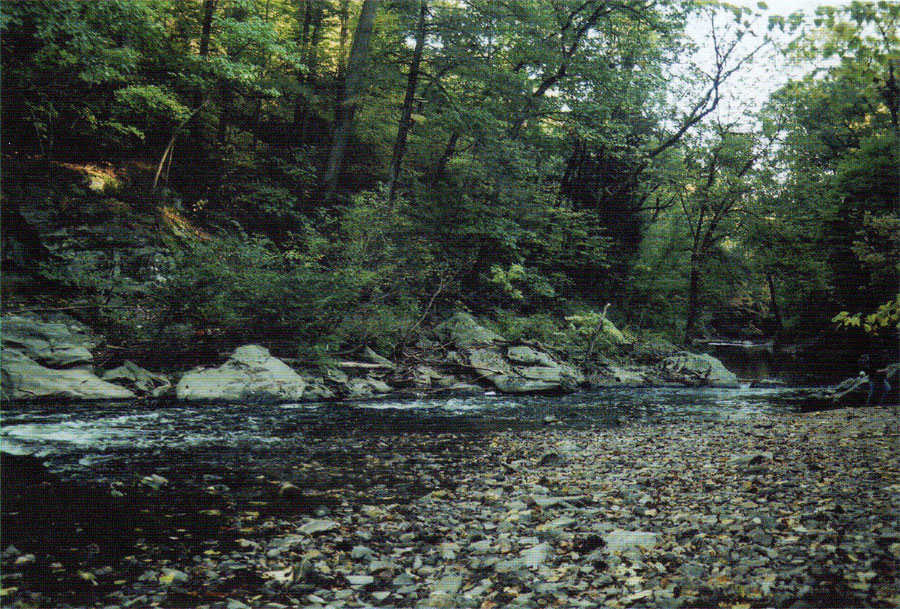
Now the Wissahiccon is of so remarkable a loveliness that, were it flowing in England, it would be theme of every bard, and the common topic of every tongue.
Edgar Allen Poe, Morning on the Wissahiccon, on a park sign at the Lincoln Drive entrance to Fairmount Park, Philadelphia, PA.
Even the normally unamiable Ambrose Bierce could find something nice to say about dogs if only in a back-handed way: “a kind of additional or subsidiary Deity, designed to catch the overflow and surplus of the world’s worship.” No doubt so, but smalls gods need their exercise, which is why I found myself trailing after my two West Highland White terriers one summer’s day on Forbidden Drive, that Arcadian stretch of rustic carriage-track which follows the Wissahickon Creek from Lincoln Drive all the way to Chestnut Hill. Scuffling and rooting their deliberate way along the roadway’s edge, Oscar and Diva drew my eye to an unexpected ‘alien object’ sticking out from a canopy of vines and moldy leaves along the embankment. Mucky white in color and looking as much as anything like a junked refrigerator, it certainly did not give the impression of being one of man’s nobler creations. But after a bit of tidying-up, I could make out that it was actually cut from marble and moreover bore an uncanny resemblance to a Roman sarcophagus, only lidless and vandalized of most of its sculpted front panel. The gradual realization of what it was soon gave way to speculation over what sort of sarcophagus it was and how it could have possibly ended up where it did in such a sorry and neglected state.
Coincidentally, I was scheduled to offer a course in Roman sculpture a month or so later in the fall of 2000. I normally ask students to write a term paper on some object in the Museum’s Roman collection. But that particular year the Roman gallery was in the early stages of renovation and thus hors de combat, so to speak. So, in order to avoid making my students trundle off to Baltimore to pick a piece in the Walters Art Gallery or to raid the New York Metropolitan, I decided to dispatch them on an Easter egg hunt in Fairmount Park. The idea would be to spot a work of Roman sculpture, type unspecified, somewhere along the five and a third mile-long drive (‘forbidden’ because it is closed to motorized traffics), record its measurements and condition, photograph or sketch it, and then hurry back to Penn to work out what it is and where it fits into the development of Roman sculpture. In other words, to combine a bit of intellectual detective work in the library with a pleasant constitutional in the fresh air, mens sana in corpore sano,“another guinea in the bank of good health,” that sort of thing. To keep the project from getting too out of hand, I promised to email weekly clues about what it was they should be looking for, while at the same time to reward quick discoveries with extra credit based on some rigmarole formula whose details I have happily forgotten.
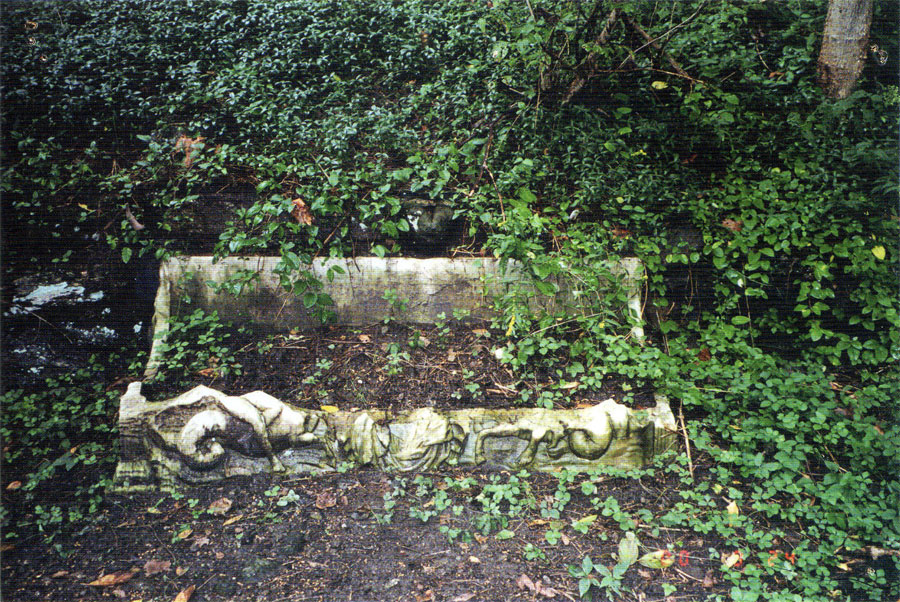
It so happens that the object in question lies just a short distance in from the Lincoln Drive entrance north of the Henry Avenue bridge. I hardly need to say that some students started at the opposite end, in Chestnut Hill, and that at least one wore holes in his sneakers walking back and forth the full ten and two-thirds miles without ever spotting the object in question.
I am not sure that most of the class’s mixed undergraduate-graduate student members carried away from this project much more than the fact that they had fallen victim to a professor who suffered bouts of bizarre behavior. This notwithstanding, two students managed to come up with memorable papers. Sarah Shaw, at the time a graduate student in the Art and Archaeology of the Mediterranean World program, wrote a highly professional report in which she nailed the mystery piece’s identity perfectly. But for her to manage this as expertly as she did, Sarah needed the help of Thomas Zabielski, who was enrolled in Penn’s College of General Studies. To her and my surprise and delight Zabielski was able to obtain photographs of the sarcophagus before it was damaged. How he managed this is a story in itself, as we shall see.
Were the walls of, let us say, a Roman house to survive to the height of a person’s chest, it might be possible to make an intelligent guess at how they continued up to the roof. This is roughly where we stand with the park sarcophagus in its current sadly depleted state. Enough bits of legs, tails, and other identifying parts survive to compare with similar pieces illustrated, for example, by Koch and Sichtermann in their com prehensive Römische Sarkophage in order to obtain a pretty shrewd idea of what was once there.
Sarah Shaw, on the other hand, was able to deal from a full deck of cards, thanks to Tom’s photos. The high points of her paper, which are echoed by many of the same conclusions reached by Tom, follow.
Carved from white marble, the park’s sarcophagus is 69” long, 28” high, and 26” deep, in other words big enough to accommodate an adult woman or medium-sized man. Because its back and two short sides were left plain, it conforms to the western type of sarcophagus intended to be set against a wall or in a niche, as opposed to the so-called Attic-Asiatic types which were fully sculpted and consequently designed to be seen from all sides.
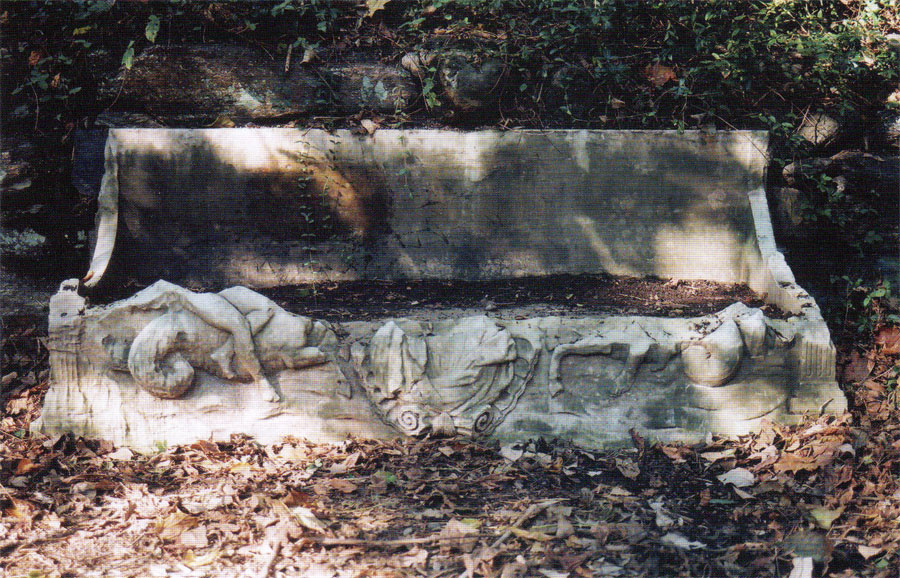
Miniature Doric pilasters at the corners frame the front panel. Its center is filled with a full portrait bust of a stern-faced woman with high cheekbones, expressive mouth, and hair styled into the so-called melon coiffure, which had come back into vogue in Roman art during the late 2nd and early 3rd century AD. Her fully clothed bust, which extends from her shoulders to her breasts, is set within an oval seashell hinged at the bottom with what may represent a rolled-up papyrus scroll.
To either side of the woman, who must represent if not actually portray the coffin’s occupant, are a pair of mirror-image marine centaurs (half-horse, half-man) carrying sea-nymphs on their backs while reaching out to touch the shell’s rim with leaves or branches (laurel, olive, ivy, or grape—the photo is too blurry to be certain) endowed with magical properties to ward off evil and ensure future bliss. Finally, a small Eros or putto flits about in each of the upper corners, dragging back the sea-nymph’s mantle to expose her unclothed body.
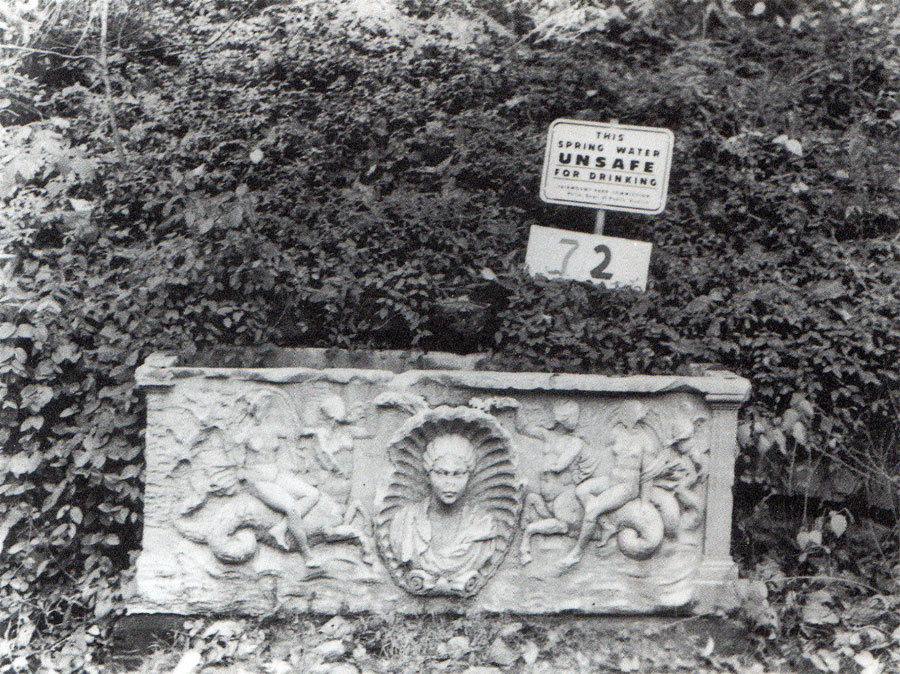
The sarcophagus belongs to the sea creature type (Meerwesen in German), which is well attested for the city of Rome and its vicinity from the late 2nd century AD until at least the reign of the emperor Gallienus (AD 253-68). When 65 years ago Andreas Rumpf published his then definitive catalogue he could tally up some 320 Meerwesen sarcophagi. The park lady’s hair, pulled back into a bun (not visible here) to leave the ears exposed, parallels the hair style associated with three-dimensional portraits of Plautilla, wife of the much-detested emperor Caracalla, and should consequently date to the first quarter of the 3rd century AD.
The remainder of Shaw’s paper deals with the various abstruse interpretations that scholars have attributed to marine life motifs when attached to the sarcophagi. Linked to Venus’s birth from the sea, death, rebirth, and the transportation of the soul to the Isles of the Blessed, these are interesting considerations but limited space here prevents further elaboration.
Tom Zabielski’s paper covers much of the same ground in addition to providing the inestimably helpful pictures of the undamaged sarcophagus. In order to lay hands on the photos, Zabielski laboriously contacted the Philadelphia Free Library, the Chestnut Hill Historical Preservation, and the Fairmount Park Commission. It was the Historic Preservation Office, Theresa Stuhlman, based in the Park Commission’s Memorial Hall head‑quarters, who produced the photos, along with the fact that the park site was known at one time as “MacFarland Springs.” And so it is that we see a stream of water issuing from the rocks directly above the open sarcophagus/water trough backed against a then neat and tidy hillside.
But whether or not the spring, subsequently labeled “unsafe for drinking” and long since dried up, derived its name from the sarcophagus’s donor cannot be said.
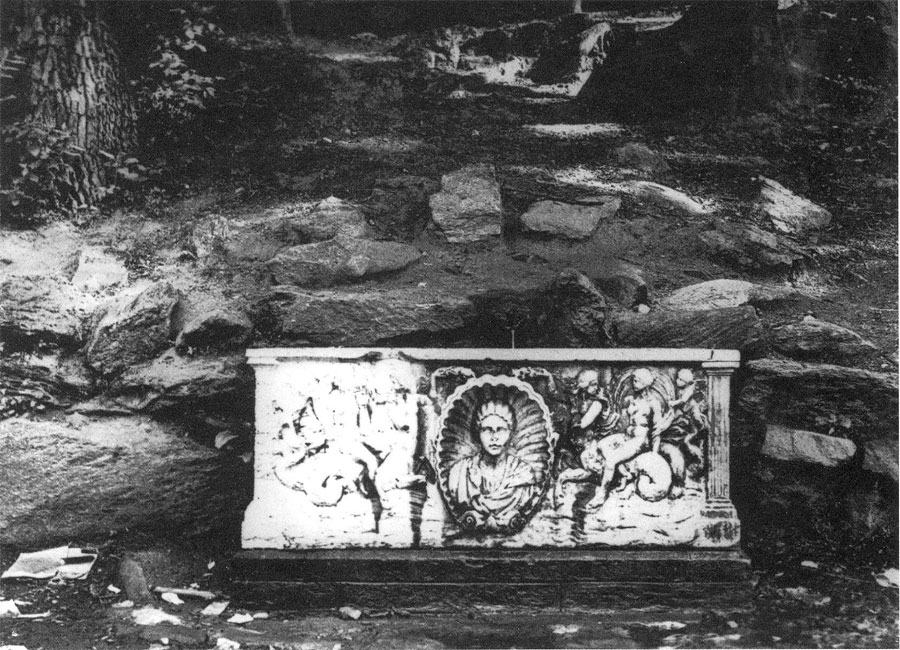
Apparently no record has survived of the latter’s name or of the date of their gift, which should serve as a cautionary tale to anyone contemplating giving the city an heirloom of their own in the near future. Joking aside, the price of antiquities has soared so high today that nobody in possession of the smallest fraction of their wits would dream of leaving a major piece of Roman sculpture in the park for 30 seconds, let alone as a “permanent” gift for our equine friends who still, let the record show, habituate the park in sizeable numbers.
Finally by way of conclusion, when I was searching through the Mediterranean Section’s holdings for objects to illustrate the Death and Burial unit in the newly renovated Roman galley, it became painfully evident that we were missing a sarcophagus. But just as I was about to set in motion the tedious process of petitioning the city to allow the Museum to remove the partially ruined “MacFarland sarcophagus”from the park and to install it in our galley, in a corner of our own lower basement storage we came upon the long-neglected but handsome marble loculus or sculpted tomb door (MS 4017) with its merry procession of Bacchic figures which is on display today. And so it was that the sarcophagus was left to slip back into its bed of slime, vines, and leaves, unrecognized, unappreciated, and probably unnoticed, one suspects, by nearly all who pass it bye.
Recently retired as Mediterranean Section Curator and Professor of Classical Archaeology, Donald White is spending most of his time cleaning out his office, writing articles, and resuming his work on a final volume in the Museum’s series of final reports on the Extramural Sanctuary of Demeter and Persephone at Cyrene. With seven volumes already published and three more in preparation, this will deal with the sanctuary’s final 250 years of architectural development as well as its cultic historic.
Koch, G., and H. Sichterman. Römische Sarkophage. Munich: C. H. Beck, 1982.
Sichterman, H. “Beiträge zu den Meerwesensakophagen.” Archäologischer Anzeiger 85 (1970):214 ff.
